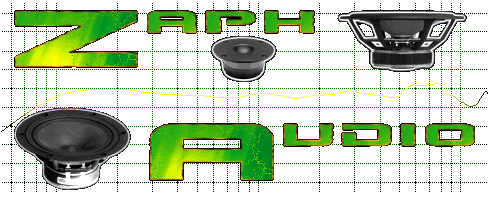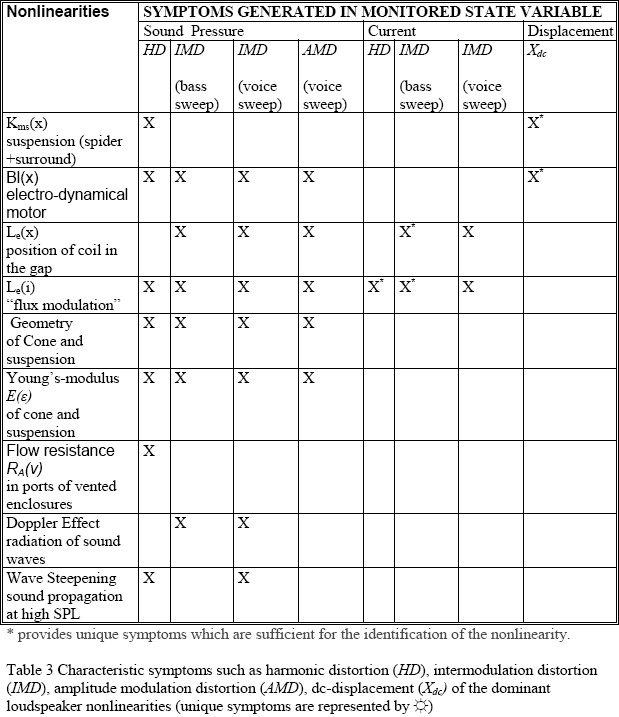Zaph|Audio - The importance of non-linear distortion

The importance of non-linear distortion
February 2, 2008
Quick definition
For those who don't know what non-linear distortion is, this article is probably not for you. It's content in a reproduced signal that is at different frequencies than the fundamental tone, but related by multipliers. Harmonic and intermodulation are 2 examples of non-linear distortion. By contrast, linear distortion is any change to the signal that doesn't change the shape of the waveform. This could mean an irregularity in the frequency response, or it could mean a change in the relative phase of the various frequencies.
Industry professionals
The importance of non-linear distortion has been been downplayed by some industry professionals. Some have even done "controlled" but seriously flawed listening tests that seem to support their position. No matter how interesting or thought provoking a test like that might be, the results are pretty meaningless if the controls promote a specific response by design. I don't take the word of every industry professional as gospel, nor should anyone else. I always take extra steps to prove things to myself, and I recommend everyone do the same. Many of the papers written in the last 30 years are garbage. Most of those papers are not subjected to peer review the way they should be, and are full of speculation, inaccuracies and outright errors. The AES library has gotten like the patent office - crap gets in easily. Many of the best papers are from the 70's and older.
This article is written more for the DIY'ers who are curious about the audibility of non-linear distortion and who may be confused by multiple conflicting reports, some that come from industry professionals. I'm not going to sit and point fingers at who I think is wrong, but I will take a moment to mention a couple of guys who do indeed know the importance of non-linear distortion: Siegfried Linkwitz and Wolfgang Klippel. Both have a lot of content available on the web for you to peruse.
Why it's so important
With respect to driver selection, non-linear distortion is very important because it's the one aspect of a driver's performance that we can't change. We are stuck with whatever non-linear distortion is inherent in a driver. We have control over system design, and we can hammer any misbehaving response curve into shape given enough crossover components. With system design, the presence of non-linear distortion has a direct link to long term listening fatigue. Short term it's a whole different story however. People have generally proven that they prefer the sound of non-linear distortion in the short term. It can be described as exciting, vibrant, or the common "detailed" before fatigue has set in. After fatigue sets in, words like bright, edgy, grainy or unclear seem to creep into the vocabulary.
What types are important?
It's important that you have spectrum information. As such, THD (total harmonic distortion) is not useful because it's just a sum that is dominated by 2nd and 3rd harmonics. It really tells you nothing about how it sounds. I never bother to report a THD number.
2 or 3 tone IMD plots are valuable because they show the entire spectrum with a robust visual result that is easily audible. They are somewhat limited however because one plot is centered on only one frequency, and many have to be done to get a true picture of a driver's or system's performance.
Harmonic distortion sweeps are valuable because the whole frequency range is shown in one plot, but limited because very tall order harmonics are not shown. The industry standard has been to report the 2nd and 3rd order HD. This is seen on some older Seas datasheets and various other manufacturers. The usefulness of this can be expanded with the inclusion of taller order HD. German magazine Hobby Hi-Fi shows 5th order in their driver reviews in addition to 2nd and 3rd order. If the 5th order is higher than the 3rd order over a frequency range, that's not looking good for the very tall harmonics. SoundEasy HD sweeps like the plots posted on this web site show 2nd order thru 5th order. While I do many types of non-linear distortion measurements, this is my prefered glimpse into non-linear performance because it's a lot of info in one image.
It's commonly said that tall order non-linear distortion is more audible than low order. In general, I'll agree with that. The part that's tough to agree on is how much more audible. Audibility of each order is not a mathematical function, it's unfortunately subjective because each order adds a distinctive coloration to the original signal. If for example, we are playing a 1kHz sine wave that has a 2nd order harmonic at -40dB and a 3rd order harmonic at -50dB, we can't say if the later is more audible. It's apples and oranges. Likewise, a 3rd order at -40dB can't be judged against a noise floor of harmonics between 6th and 10th at -70dB. You've got to hear the whole package together and make a judgement call.
It's been said that low, even order harmonics are not as annoying as taller, odd order harmonics. I will agree with that. It's also been said that 2nd order HD actually sounds enjoyable. I will disagree with that. Any non-linear distortion will take away from the clarity of the original signal. It's up to you to decide what you can stand.
There are some other important issues that may get in the way of interpeting non-linear distortion measurements. For example, distortion has phase information, which may affect how it sums with the fundamental. But make no mistake - what is seen in a non-linear distortion measurement can be heard, one way or another.
What is non-linear distortion made of?

This can be summed up very well in Wolfgang Klippel's 2006 paper "Loudspeaker Nonlinearities - Causes, Parameters, Symptoms". That paper is one of the few good articles available at the AES Library. The bonus is that Wolfgang makes it available for free on his website. You can download it here. [1.4 megs, PDF]
What goes wrong with listening tests?
Quite to the point, most listening tests are not long enough. Listening fatigue can take a long time to set in, sometimes more than an hour. Once it does set in, your brain will have learned what listening fatigue sounds like for that particular speaker. Then with each subsequent listening session, the listening fatigue sets in faster as your memory of that speaker's sound returns. If it's bad enough, it will get to a point where you can't stand it and you avoid listening altogether.
It's a sad fact that many commercial high distortion speakers are better sellers because of the initial short term preference for higher distortion. It either leads to buyer's remorse a couple weeks down the road, or just a mental fight to continue accepting the initial first impression.
In the DIY community, many designs are released far too early, before the designer has a chance to let the sound sink in. No designer should post a design without listening to it a lot, maybe even a month. Much longer if no non-linear distortion data is involved in the design, and the ears are the only tools.
As I've mentioned in the "evaluation myths" article, first impressions are generally wrong. This does not bode well for selecting a speaker on a showroom floor, picking a winner at a DIY event or getting valuable results from a controlled test that is far too short to have any real meaning.
The Real Test
There's only one real test that will truly point out the importance of non-linear distortion. I've done it myself several times, as have a few others in the DIY speaker community. Ironically, I haven't seen it done too much by industry professionals. It would almost appear they would prefer come to conclusions by theorizing rather than listening that immediately follows testing.
The "real test" is real simple. Essentially, you create 2 identical systems where everything is the same except for non-linear distortion. Then you listen and compare for a long time. The 2 systems must have identical response curves, enclosures, crossover points, driver sizes and driver baffle locations. Obviously the drivers will be different, though the individual driver rolloffs after filtering must also be the same. The systems must be played at the same fundamental level at the same location in the listening room. By "fundamental level" I mean a tone's actual level that does not include it's harmonics. You can't truly check a level with a Rat Shack SPL meter, you must use a calibrated RTA to show the fundamental without summing in the harmonics. A-B switching will not work here because one system cannot occupy the same space as the other system. When all this is done, the difference you hear will be non-linear distortion - and it will be obvious. In the short term, the system with lower non-linear distortion may sound dead or lifeless, but given enough listening, this will be the preferred system as the fatigue of the higher distortion system sets in.
Experience is the only answer
Designers who've gotten by designing systems using only response curves without any non-linear distortion data will be the first ones to declare non-linear distortion data as not important. These folks have not yet linked what's visible in a harmonic distortion sweep or IMD plot to what they hear. Likewise, designers (amatuer or professional) who base all their work on short term listening will never see the value of a system with low non-linear distortion. Be careful who you take advice from - ignorance spreads like a disease.
The only way to recognize the true value of non-linear distortion measurements is to work with them - often.
Yours Truly, John "Zaph" Krutke © 2008
Back to -Zaph|Audio-